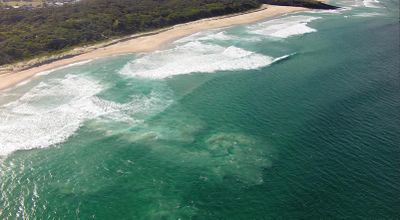Difference between revisions of "Rip current"
From MarineSpecies Traits Wiki
Dronkers J (talk | contribs) |
Dronkers J (talk | contribs) |
||
| Line 1: | Line 1: | ||
{{Definition|title=Rip current | {{Definition|title=Rip current | ||
| − | |definition= | + | |definition = Rip currents are strong offshore directed currents that occur when high waves break over nearshore sandbars. |
}} | }} | ||
| − | == | + | |
| + | |||
| + | ==Notes== | ||
| + | When breaking, high waves raise the water level in the area between the beach and [[nearshore sandbars]]. This elevated water is discharged by rip currents that flow seaward through narrow gaps between the nearshore bars. The corresponding morphological pattern is called "rip cell". It results from the [[Coastal morphodynamics|morphodynamic feedback]] between the [[coastal morphology]] and the incident wave field. A local setback in the shoreline is often seen opposite the rip opening. The rip opening travels slowly downstream. Rip currents are dangerous for swimmers. | ||
| + | |||
| + | |||
| + | |||
| + | {| border="0" align="center" | ||
| + | |- | ||
| + | | valign="top"| | ||
| + | [[File:RipBurrillBeach_DarylGama.jpg|thumb|400px|left|Rip currents at Burrill Beach, South Coast NSW, Australia. The strength of the current is illustrated by the offshore plume of sediment that is stirred up from the seabed. Photo credit Daryl Gama. https://www.scienceofthesurf.com/]] | ||
| + | | valign="top"| | ||
| + | [[File:DutchCoastNorthHolland.jpg|thumb|left|350px|Rip cell at the barred coast of North Holland, The Netherlands. Photo credit Rens Jacobs https://beeldbank.rws.nl/ ]] | ||
| + | |} | ||
| + | |||
| + | |||
| + | |||
| + | ==Related articles== | ||
:[[Rhythmic shoreline features]] | :[[Rhythmic shoreline features]] | ||
:[[Currents]] | :[[Currents]] | ||
| − | :[[ | + | :[[Nearshore sandbars]] |
| + | |||
==References== | ==References== | ||
<references/> | <references/> | ||
Revision as of 20:24, 29 March 2021
Definition of Rip current:
Rip currents are strong offshore directed currents that occur when high waves break over nearshore sandbars.
This is the common definition for Rip current, other definitions can be discussed in the article
|
Notes
When breaking, high waves raise the water level in the area between the beach and nearshore sandbars. This elevated water is discharged by rip currents that flow seaward through narrow gaps between the nearshore bars. The corresponding morphological pattern is called "rip cell". It results from the morphodynamic feedback between the coastal morphology and the incident wave field. A local setback in the shoreline is often seen opposite the rip opening. The rip opening travels slowly downstream. Rip currents are dangerous for swimmers.
 Rip currents at Burrill Beach, South Coast NSW, Australia. The strength of the current is illustrated by the offshore plume of sediment that is stirred up from the seabed. Photo credit Daryl Gama. https://www.scienceofthesurf.com/ |
 Rip cell at the barred coast of North Holland, The Netherlands. Photo credit Rens Jacobs https://beeldbank.rws.nl/ |
Related articles
